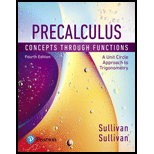
In Problems 1 and 2, determine whether each relation represents a function. For each function, state the domain and range.
Whether the provided relation is function or not and state the domain and range.
Answer to Problem 1RE
Solution:
The provided relation is a function. The domain of this relation is , and its range is .
Explanation of Solution
Given:
It is provided in the problem that the relation of the sets is .
Formula used:
Definition: Let and be two nonempty sets, A function from into is a relation that associates with each elements of exactly one element of .
The set is called the domain of the function. For each element in , the corresponding element in is called the value of the function at , or the image of . The set of all images of the elements in the domain is called the range of the function.
The inputs of the provided sets are and 4. The outputs are 0,3 and 0
This relation is a function because there are no ordered pairs with the same first element and different second elements.
The domain of this relation is , and its range is .
Want to see more full solutions like this?
Chapter 1 Solutions
Precalculus: Concepts Through Functions, A Unit Circle Approach to Trigonometry (4th Edition)
- Explain the key points and reasons for the establishment of 12.3.2(integral Test)arrow_forwardUse 12.4.2 to determine whether the infinite series on the right side of equation 12.6.5, 12.6.6 and 12.6.7 converges for every real number x.arrow_forwarduse Cauchy Mean-Value Theorem to derive Corollary 12.6.2, and then derive 12.6.3arrow_forward
- Explain the focus and reasons for establishment of 12.5.1(lim(n->infinite) and sigma of k=0 to n)arrow_forwardExplain the focus and reasons for establishment of 12.5.3 about alternating series. and explain the reason why (sigma k=1 to infinite)(-1)k+1/k = 1/1 - 1/2 + 1/3 - 1/4 + .... converges.arrow_forwardExplain the key points and reasons for the establishment of 12.3.2(integral Test)arrow_forward
- Use identity (1+x+x2+...+xn)*(1-x)=1-xn+1 to derive the result of 12.2.2. Please notice that identity doesn't work when x=1.arrow_forwardExplain the key points and reasons for the establishment of 11.3.2(integral Test)arrow_forwardTo explain how to view "Infinite Series" from "Infinite Sequence"’s perspective, refer to 12.2.1arrow_forward
 Glencoe Algebra 1, Student Edition, 9780079039897...AlgebraISBN:9780079039897Author:CarterPublisher:McGraw Hill
Glencoe Algebra 1, Student Edition, 9780079039897...AlgebraISBN:9780079039897Author:CarterPublisher:McGraw Hill Algebra: Structure And Method, Book 1AlgebraISBN:9780395977224Author:Richard G. Brown, Mary P. Dolciani, Robert H. Sorgenfrey, William L. ColePublisher:McDougal Littell
Algebra: Structure And Method, Book 1AlgebraISBN:9780395977224Author:Richard G. Brown, Mary P. Dolciani, Robert H. Sorgenfrey, William L. ColePublisher:McDougal Littell

 College Algebra (MindTap Course List)AlgebraISBN:9781305652231Author:R. David Gustafson, Jeff HughesPublisher:Cengage Learning
College Algebra (MindTap Course List)AlgebraISBN:9781305652231Author:R. David Gustafson, Jeff HughesPublisher:Cengage Learning Trigonometry (MindTap Course List)TrigonometryISBN:9781337278461Author:Ron LarsonPublisher:Cengage Learning
Trigonometry (MindTap Course List)TrigonometryISBN:9781337278461Author:Ron LarsonPublisher:Cengage Learning





